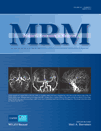Quantitative susceptibility mapping of small objects using volume constraints
Abstract
Microbleeds have been implicated to play a role in many neurovascular and neurodegenerative diseases. The diameter of each microbleed has been used previously as a possible quantitative measure for grading microbleeds. We propose that magnetic susceptibility provides a new quantitative measure of extravasated blood. Recently, a Fourier-based method has been used that allows susceptibility quantification from phase images for any arbitrarily shaped structures. However, when very small objects, such as microbleeds, are considered, the accuracy of this susceptibility mapping method still remains to be evaluated. In this article, air bubbles and glass beads are taken as microbleed surrogates to evaluate the quantitative accuracy of the susceptibility mapping method. We show that when an object occupies only a few voxels, an estimate of the true volume of the object is necessary for accurate susceptibility quantification. Remnant errors in the quantified susceptibilities and their sources are evaluated. We show that quantifying magnetic moment, rather than the susceptibility of these small structures, may be a better and more robust alternative. Magn Reson Med, 2013. © 2012 Wiley Periodicals, Inc.




